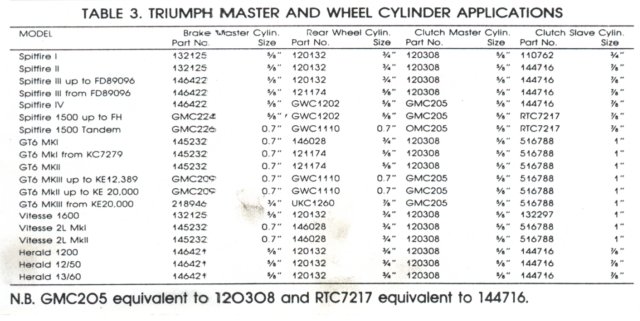

Tech Zone
The Triumph Range 1960 to 1980
As you may be aware many Triumph parts are common amungst the club cars. However there are parts which can be swapped with other Triumphs like the Dolomite and 2000 seriers. These cars are readily available at most breakers yards and as such a good source for those otherwise hard to find parts.
Small Saloons
The first being the 1300 Triumph Saloon ariving on the scene in 1965, this
car mad its way into the market labeled as the baby brother of the Triumph 2000
MK1 Saloon, they shared styling which provided a focal point for modern car
manufacturers to follow - for instance look at the Vauxhall Vectra and the Astra
do you notice anything? The 1300 saloon was front wheel drive, the transmission
was by way of flexible front drive couplings. This was the first time the "rubber
doughnuts" had been used, later they were put into manufacture on the Vitesse
and GT6 Rotoflex rear suspension! The Triumph 1300 was the first trial of Triumphs
1300cc engine which later found its way under the bonnet of the Spitfire MKIII.
In '67 a faster Triumph 1300TC Saloon joined the team. Essentialy it was just
a twin carburetted version of the Spitfire MKIII engine. The body and height
of trim barely changed until 1970, in this year big changes were made! All the
Triumph saloons were restyled to produce a common style theme accross the range
which was based on the Stag.
The top of the range became the Triumph 1500 Saloon fitted with a 1500cc engine. The drive was still to the front wheels. This car used the new Triumph 1500cc engine which could produce 61bhp (DIN), this was three yeays before it was fitted to the American Spitfire IVs and four years before it was fitted to the Spitfire1500 1974. Keeping four doors the body was completely restyled in line with the new company image.The front and rear both had surgery and this provided 20% more boot space and the ability to fit a larger engine if required. The front was deisgned with a new grill and four headlights in a twin configuration. 1971 a power increase was put into action bringing the power from 61bhp to 65bhp, this became known as the silver label 1500.
The econemy version becmae the Toledo. Another milestone in the changes to Triumph motoring was the Toledo was rear wheel drive! The tried and tested 1300cc engine was dropped in. It was very similar to the 1500 saloon, however many of the panels were changed. The floor pan changed to accomodate the rear wheel drive. The back end was changed to fit in with the Triumph styling. Due to the rear wheel drive the boot space was reduced on the 1300. Although the front was re-designed to incorporate the new company styling it was not lengthened. The front grill was differant too, two rectanglular headlights were favoured instead of the quadruple lights in the 1500. In 1972 the Toledo became availble in two or four door varieties with the cabin space remaining the same.
Also in 1972 the Triumph Dolomite was added to the range. Using the new 1850cc slant engine (same which was produced for Saab) to deliver power once again to a rear wheel drive car. From March 1973 overdrive was produced as an option for the car. Triumph decided instead of adopting the RWD bodyshell of the Toledo to convert the long nose and tail of the FWD 1500 Saloon to RWD for the Dolomite by changing the floorplan. The front grill remained the same. By 1972 Triumph had to produce four differant body shells:
1. A long nose and tail FWD version for the 1500 Saloon
2. A long nose and tail RWD version for the Dolomite
3. A Short nose and tail RWD two door for the Toledo
4. 3. A Short nose and tail RWD four door for the Toledo
1973 saw the introduction of the Dolomite Sprint. This had 4 valves per cylinder, 2 litre version of the inclined 1850cc engine! A new suspension and transmission system was used but the shell and interior were the same as the Dolomite. 1973 was also the end for front wheel drive Triumphs when the 1500 Saloon was discontinued thus making room for the Triumph 1500TC Saloon which was rear wheel drive. The long nose and tail shell of the RWD bodyshell already used by the dolomite was used for the new 1500TC. By fitting twin SU carbs to the 1500 engine power was increased to 71BHP. It was very similar to it's forefather the trusted Dolomite.
1976 the range was getting out of hand a few cuts here and there left the market with:
Dolomite 1300 (1300cc)
Dolomite 1500 (1500cc Twin SU))
Dolomite 1850HL (1850cc Twin SU)
Dolomite Sprint (2000cc Twin SU)
A 1300cc twin SU was never introduced and a single 1500 was never produced. Overdrive was available on all models except the 1300, and was standard on the Sprint. All models used the same long nose and tail bodyshell. To distinguish the models differant badges were used. The 13 and 1500 used the rectangular headlamps of the Toledo the others used the twin headlights. The 1850HL and Sprint were given a complimentory front spoiler. The interior was updated to clothe seats and head rests, with a few other minor alterations. The 13 and 1500 has simplistic dashboards with only two clocks. The three higher end models were embelshied with rev counter, clock, temp, volt and fuel dials. The range didn't change until 1980 when it was phased out.
The Triumph 2000 Saloons
The first replacement for the 1960 standard Vanguard 6 and condemed
Zebu had to be scraped as it looked too much like Fords Anglia! So instead came
the arival of the Michelotti styled Barb or Triumph 2000 MK1. This was introduced
in 1963 at the Earls Court Motor Show. It was the first Triumph to be designed
and produced under the ownership of Layland.
The four door bodyshell was born from a fresh design, however many mechanical
aspects were taken from the Vangaurd 6. The 2 litre 6 cylinder engine was derived
from the Vangaurd 6. This engine was able to produce a steady 90BHP (NETT) in
twin Stromberg form. This same engine was to be used in the Vitesse2 and the
GT6 MK1. The gearbox was developed from the design of the Vanguard but used
with a TR4 gear linkage. Overdrive and a Borg Warner type 35 automatic were
options right from the start. Suspenssion was quadrally independant. Due to
the competition from the Rover 2000 the trim and upholstery levels were maintain
highly. In 1965 the back was reshaped to include an estate version in the range.
In 1968 a more powerfull lump was introducde it was the detuned TR5 2498cc petrol
injected engine, this became known as the 2.5PI MKI. 1969 became the year of
the launch for the estate version. In october '69 a big restyle was underway
accross the entire range, as a reuslt the 2.5PI MKI Saloon and in particular
the Estate are very rare.
1970 as mentioned earlier was a year in which styling would change for all standard Triumphs. This was the birth year for the Triumph 2000 MKII. The rear and nose were stretched and re-styled. The codename at the plant for the re-style of the saloons was 'Insbruck'. The interior was updated, the dash was improved to become more clear for the clocks and the switches were placed in a logical array. From now on the dash would be completely vaneered.
The mechanical aspect remained mostly the same, with the what has now become known as the 2 litre MKII engine was fitted, with the full width cylinder head from the 2500cc engine. The power output was quoted at 84BHP (DIN). The same engine was already in use in the GT6 MKII and 2 litre MKII Vitesse - a first for club cars! The estate version was introduced as was the 2.5 PI engined options, making a four car line up for the range. The Lucas PI was very unreliable and very expensive to repair and service. It was decided to phase the engine out in two stages. May 1974 the Triumph 2500TC was introduced as a saloon and estate. It was essentialy the 2.5PI MKII without the petrol injection but with twin HS4 carbs and a milder cam giving 99BHP which when injected produced 118BHP.
At the same time the Triumph 2000 MKII was fitted with twin SU HS4 carbs and became the Triumph 2000TC. The 2.5PI was also introduced which was called Triumph 2000PI. This was short lived the 2500PI was ousted in December '74, the new saloon lived on until June 1975. It was to be replaced with the Triumph 2500S. This was a carb version of the 2500cc engine, but by fitting bigger HS6 SU carbs, new inlet manilfold and a differant cam power was upped to 106BHP. It also had a better fuel consumption. The 2500S had power stearing and overdrive as standard 14" alloy wheels (Stag) were fitted a front roll bar was added which enabled softer front springs to be used making for a more comfortable ride. Variations were made to the 2500TC including engine updates. 1977 introduced their replacements the Rover 2300 and 2600.
Triumph Designations
|
Model
|
Year
|
Commission number
|
Engine number
|
Gearbox numebr
|
Differential numebr
|
Differential ratio
|
| Spitfire MKI MK II MKIII MK IV 1500 |
|
FC FC50001 FD FH FH75001 |
FC FC5001 FD FH FH |
FC FC FD FH FR |
FC FC FD FH FR |
4.11 4.11 4.11 3.89 3.63 |
| GT6 MKI MKII MKIII |
Oct 1966 - Sep 1968 Oct 1968 - Dec 1970 Oct 19070 - Dec 1973 |
KC KC50001 KE |
KC KC50001 KE |
KC KC50001 KE |
KC KC/KD KC/KD |
3.27 3.27/3.89 3.27/3.89 |
| STAG |
Jul 1970 - May 1977
|
-
|
-
|
-
|
-
|
3.7
|
Comparison of 1300cc and 1500cc engine components
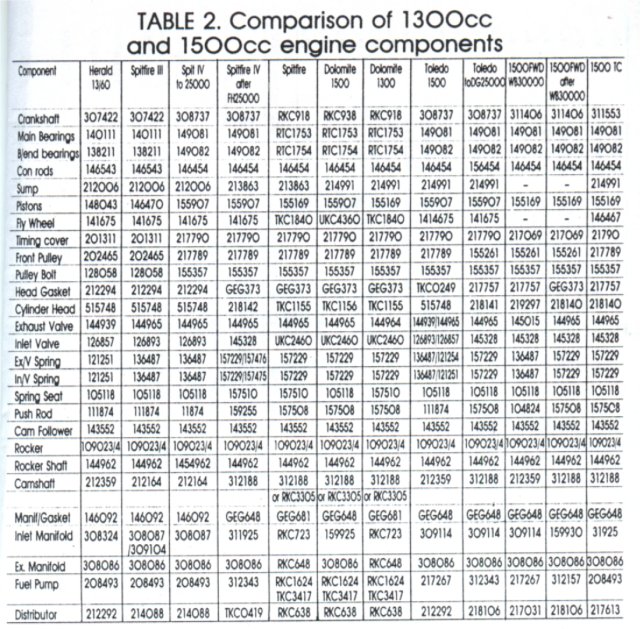
Please note I respect the copyright owner of the above table - however I don't know where it came from!
Gearbox and Clutch Applications
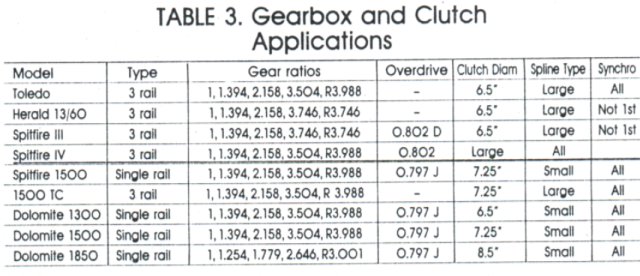
1300 and 1500 Engine Specifications
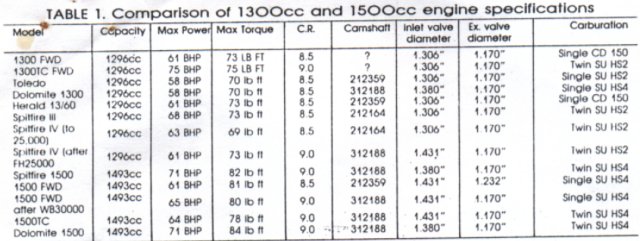
Front Spring Applications
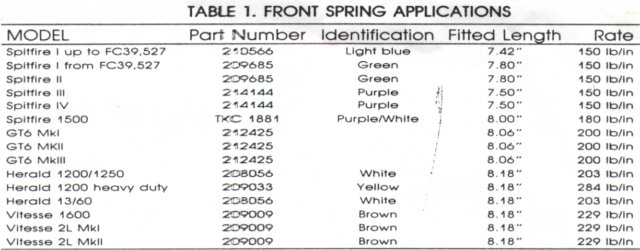
Rear Spring and Differential Applications
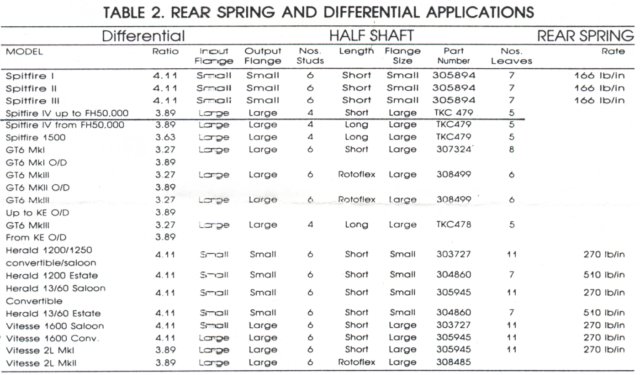
Master and Wheel Cylinder Applications
